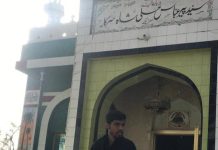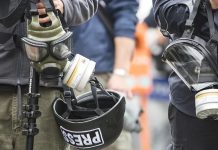Bannu: Aiman, 13, is a student of 5th grade in a local school in the North Waziristan Agency (NWA). Hers is the only functioning school in the entire tribal agency where the military recently concluded its Zarb-e-Azb offensive against militants, started on June 15, 2014.
Two years ago, when Aiman and her family were displaced in the wake of military operation, she was a student of the same class. On returning home recently, she joined the same grade where she had left.
According to local education authorities, more than 33,000 girls are out of schooling North Waziristan are out of school due to the military operation.
“It was very hard for us to send our girls to schools when we were in our own villages. Now that we are displaced, it is impossible to send them to schools in a place where we are dubbed as mutaseerin ,” Farhad Ali, a tribesman from NWA, told News Lens Pakistan.
‘Mutaseerin‘ is a derogatory term used for those affected by conflict, as it assigns second class status to IDPs.
“My daughter used to top her class and I was hopeful she would complete her education in time but now she has lost two precious years,” Aiman’s father Noor Hassan, who works as a driver in Saudi Arabia, told News Lens.
“I realized the value of education after going abroad,” he said.
Like many tribesmen from NWA, Hassan sought employment in one of the Arab Gulf states, where menial jobs like labour and driving are available.
Aiman is one of the thousands of girls from the tribal region who said goodbye to education when they were displaced by the military operation against militants who opposed female education, often violently by bombing schools.
The FATA Secretariat that overlooks development projects in tribal areas estimates the rate of female literacy in the tribal areas is a mere three per cent. The Educational Management Information System (EMIS) of the Education Department in Khyber Pakhtunkhwa puts the figure even lower, at 1.74 per cent.
In its report for 2014-15, EMIS for FATA stated that 25,980 girl students aged 4 to 9 were enrolled in primary schools of North Waziristan Agency during 2014, while 1187 girls aged 10 to 14 were enrolled at secondary level.
There are 381 primary education institutions in North Waziristan including community schools and mosque schools for girls.
The “mosque schools” are based established in a hujra attached to a mosque and run by a mosque imam holding a position of a theology teacher or TT. These schools are established and managed by the FATA Directorate of Education.
The number of middle schools in NWA is about 34 with 664 girls enrolled. There are only nine high schools in NWA with 677 girls enrolled from across the agency.
The literacy rate in NWA is no more than 0.15 percent for girls while 17 per cent for boys, according to a source associated with EMIS who wanted to stay anonymous because he is not authorized to speak to media.
An EMIS survey conducted late 2015 found that about 200,000 students had been affected by the military operation in North Waziristan Agency, including 25,000 high school to college-level students and 175,000 middle school students.
Ruhul Islam, a displaced tribesman from NWA who lives in suburbs of Bannu, told News Lens Pakistan that the government had announced plans to accommodate displaced students in schools of Bannu, Peshawar and other districts where the displaced people took shelter.
But when it came to girl students, he said, there were no plans.
“Girls who would go to schools in their native areas despite resistance from a tribal milieu or threat from militants were forced to stay home,” Islam told News Lens Pakistan.
“How could we send them to schools in a setting alien to us, when we don’t even know whether the environment in schools is safe for our girls? We were worried about our safety and livelihood. For many of us, schooling our kids was the last thing to worry about after we got displaced.”
Parents see this as a serious blow to the fragile and abysmal situation of female education in the area.
In recent years, militancy in the tribal region including NWA has set back female education considerably, with local militants issuing pamphlets banning girls’ education and warning parents of dire consequences if they sent their sons and daughters to school.
The conservative local culture had always been a major hindrance to female education. Nevertheless many locals still want to educate their girls.
They, however, could not afford to annoy the all – powerful Taliban or resist their growing influence in the region.
The absence of middle and high schools in places easily accessible to girls also tends to discourage higher education in a place where parents do not want their daughters to go to school after attaining puberty.
Hamayoun Khan Dawar, a social worker and tribal elder, said schools in tribal areas are not meant to educate people. He said they were offered to local influential elders as a reward for their cooperation with the political administration.
When they donated land to build schools, the elders came to own the schools that should be community property.
“Mostly these schools are used as hujras, not schools,” Dawar told News Lens Pakistan.
“In the odd case where they are used as schools, female members of the owner’s family are appointed as teachers. They are often not qualified and appointed as a favour to the landlord, in violation of merit.”
Deputy Director Female Education Gul Rukh said the Education Department was taking steps to bring back girls whose education had been disrupted by displacement.
“We are well aware of the drop-out ratio of girl students all over FATA and especially that of North Waziristan Agency which has a drop-out ratio of 72 per cent,“ she said.
She said maliks who were using schools as their guest houses would be dealt with strictly.
“I myself saw that the residences of female teachers were occupied by the owners,” said Gul Rukh.
“How can a female teacher who is not from the local area focus on teaching when she is deprived of the safety and comfort of her own place?”
Despite the harsh realities, many parents still wish to send their girls to schools for a proper education.
Abdullah Khan is father of two daughters who are back at school after returning to their village following a long spell of displacement.
“I have learned from experience and hard circumstances that education is not just the right of male children,” said Khan.
“My daughters must have good education if they have to be prepared for life’s uncertainties.”



